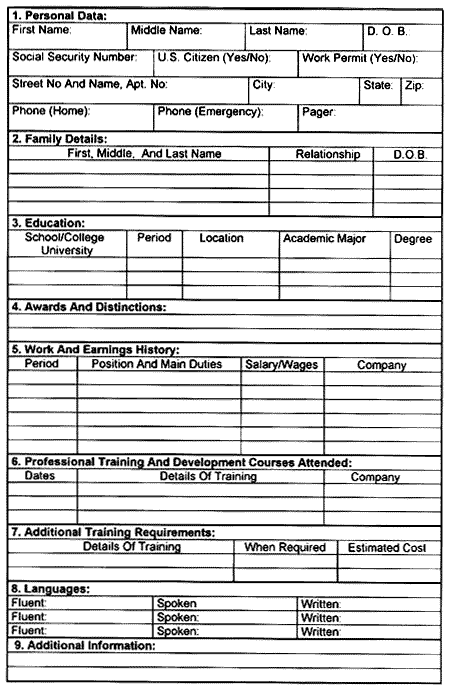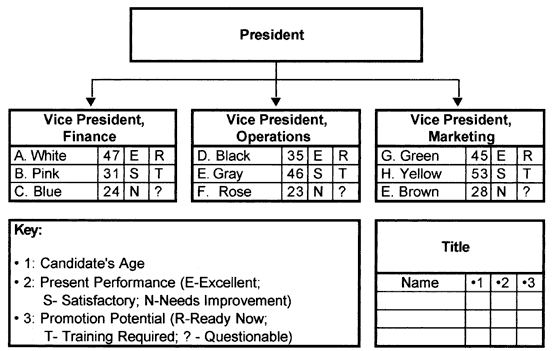HUMAN RESOURCES MANAGEMENT
CHECK POINT 31: MANAGEMENT DEVELOPMENT
This Check Point Is Available By Subscription Only,
But You Can Still Check Out The Menu Below. |
|
|
| |
|
DO I NEED TO KNOW THIS CHECK POINT?
|
| |
HUMAN RESOURCES MANAGEMENT
CHECK POINT 31: MANAGEMENT DEVELOPMENT
Please Select Any Topic In Check Point 31 Below And Click. |
|
|
| |
|
DO I NEED TO KNOW THIS CHECK POINT?
|
| |
WELCOME TO CHECK POINT 31 |
|
| |
HOW CAN YOU BENEFIT FROM CHECK POINT 31? |
| |
| The main purpose of this check point is to provide you and your management team with detailed information about Management Development and how to apply this information to maximize your company's performance. |
| |
| In this check point you will learn: |
| |
• About the importance of management development.
• About various tools for evaluating management promotional potential.
• How to develop and use an employee record.
• How to develop and use a management replacement chart.
• How to classify management development needs
• About typical management development needs.
• About management development methods.
• About managerial-on-the-job training.
• About professional management coaching.
• About job rotation, seminars, workshops, self-study courses... and much more. |
| |
LEAN MANAGEMENT GUIDELINES FOR CHECK POINT 31 |
| |
| You and your management team should become familiar with the basic Lean Management principles, guidelines, and tools provided in this program and apply them appropriately to the content of this check point. |
| |
| You and your team should adhere to basic lean management guidelines on a continuous basis: |
| |
| • |
Treat your customers as the most important part of your business. |
| • |
Provide your customers with the best possible value of products and services. |
| • |
Meet your customers' requirements with a positive energy on a timely basis. |
| • |
Provide your customers with consistent and reliable after-sales service. |
| • |
Treat your customers, employees, suppliers, and business associates with genuine respect. |
| • |
Identify your company's operational weaknesses, non-value-added activities, and waste. |
| •. |
Implement the process of continuous improvements on organization-wide basis. |
| • |
Eliminate or minimize your company's non-value-added activities and waste. |
| • |
Streamline your company's operational processes and maximize overall flow efficiency. |
| • |
Reduce your company's operational costs in all areas of business activities. |
| • |
Maximize the quality at the source of all operational processes and activities. |
| • |
Ensure regular evaluation of your employees' performance and required level of knowledge.
|
| • |
Implement fair compensation of your employees based on their overall performance.
|
| • |
Motivate your partners and employees to adhere to high ethical standards of behavior. |
| • |
Maximize safety for your customers, employees, suppliers, and business associates. |
| • |
Provide opportunities for a continuous professional growth of partners and employees. |
| • |
Pay attention to "how" positive results are achieved and constantly try to improve them. |
| • |
Cultivate long-term relationships with your customers, suppliers, employees, and business associates. |
|
|
|
1. MANAGER - IS IT A PROFESSION? |
 |
|
ABOUT MANAGERS |
Business owners and managers must be prepared to invest time, effort, and money into the never-ending management education process in order to succeed in business.
Until fairly recently the profession of Manager had no clear descriptive definition unlike professions such as engineer, medical doctor, or accountant. This situation, however, has changed since the introduction of several professional management programs.
Such programs include Master Of Business Administration (MBA) programs offered by various universities and business schools, seminars offered by specialized providers, such as American Management Association or a self-study management program offered by Lean Business Club. |
According to Scott Williams, there are Top 10 Differences Between Managers And Leaders. and, probably the most important difference is this: |
Managers change things, leaders change the world. |
| |
ADDITIONAL INFORMATION ONLINE |
|
|
|
2. IMPORTANCE OF MANAGEMENT DEVELOPMENT |
 |
|
IMPORTANCE OF MANAGEMENT DEVELOPMENT |
Management Development is of prime importance to most organizations. It facilitates continuous growth, motivation, and promotion of employees to senior positions within the company. According to a recently conducted survey of employers, 90% of supervisors, 73% of middle-level managers, and 51% of executives were promoted from within. Most of these managers, however, required additional training.
Management development starts with a detailed Assessment Of Managerial Skills that may be required by the company in the future. This depends upon the company's short-, medium-, and long-term plans and objectives. It is essential, therefore, to evaluate the Promotional Potential Of Managers currently employed by the company and to identify the need for further managerial development.
The promotion potential of managers can be evaluated in several ways illustrated below. |
EVALUATION OF THE MANAGEMENT PROMOTIONAL POTENTIAL |
 |
 |
Employee Record |
Management Replacement Chart |
| Evaluation and review of the manager's Employee Record. |
Development and evaluation of a Management Replacement Chart. |
|
|
| |
ADDITIONAL INFORMATION ONLINE |
|
|
|
3. EMPLOYEE RECORD |
 |
|
EMPLOYEE RECORD |
The promotion potential of managers can be evaluated by reviewing the individual Employee Record compiled on each employee within the organization. This record includes information such as details of education, professional courses, career and development interests, additional training requirements, and details of skills and experience.
A typical employee record in a small or medium-sized company has been presented earlier in human resources planning and forecasting and is repeated below. |
| |
ADDITIONAL INFORMATION ONLINE |
|
|
|
4. SMALL BUSINESS EXAMPLE
EMPLOYEE RECORD |
 |
|
EMPLOYEE RECORD |
 |
|
|
5. MANAGEMENT REPLACEMENT CHART |
 |
|
MANAGEMENT REPLACEMENT CHART |
The promotion potential of managers can also be evaluated by developing and reviewing the company's Management Replacement Chart. This chart includes names of several candidates for the most important positions within the organization and summarizes present performance and promotion potential for each candidate.
A typical management replacement chart in a small or medium-sized company has been presented earlier in employee planning and forecasting and is repeated below. |
| |
ADDITIONAL INFORMATION ONLINE |
|
|
|
6. SMALL BUSINESS EXAMPLE
MANAGEMENT REPLACEMENT CHART |
 |
|
 |
|
7. MANAGEMENT DEVELOPMENT NEEDS |
 |
|
MANAGEMENT DEVELOPMENT NEEDS |
| Management Development Needs depend upon the specific managerial level and are summarized next. All management development needs may be classified into three categories illustrated below. |
| |
CLASSIFICATION OF MANAGEMENT DEVELOPMENT NEEDS |
 |
|
 |
|
 |
Management
Development
Needs For
Executive
Level
Managers |
|
Management
Development
Needs For
Middle
Level
Managers |
|
Management
Development
Needs For
Supervisory
Level
Managers |
|
|
| |
ADDITIONAL INFORMATION ONLINE |
|
|
|
8. TYPICAL MANAGEMENT DEVELOPMENT NEEDS |
 |
|
ARE YOU READY TO IMPROVE YOUR MANAGEMENT SKILLS? |
You and your management team must continuously develop and improve your management skills to ensure successful performance of your company. Typical Management Development Needs in are summarized below. |
TYPICAL MANAGEMENT DEVELOPMENT NEEDS |
Executive Level
Managers |
|
Supervisory Level
Managers |
- • Improving decision making process.
- • Developing strategies and policies
- • Setting business objectives and priorities.
- • Preparing budgets.
- • Planning operational activities.
- • Building management teams.
- • Organizing human resources.
- • Selecting and hiring managers.
- • Motivating managers and employees.
- • Counseling and coaching managers.
- • Understanding human behavior.
- • Evaluating and appraising managers.
- • Organizing financial resources.
- • Developing financial management systems.
- • Organizing human resources.
- • Holding effective meetings.
- • Developing effective communication.
- • Ensuring sound labor-management relations.
- • Managing time.
- • Coping with daily stress.
- • Conducting self-analysis.
|
|
- • Assisting top management.
- • Setting objectives and priorities.
- • Improving decision making process.
- • Recruiting and hiring employees.
- • Screening and testing employees
- • Interviewing employees.
- • Conducting employee orientation.
- • Motivating employees.
- • Counseling and coaching employees.
- • Developing and training employees.
- • Evaluating and appraising employees.
- • Organizing and planning operational activities.
- • Providing leadership.
- • Ensuring good communication.
- • Understanding human behavior.
- • Implementing operational plans.
- • Ensuring discipline in the workplace.
- • Ensuring sound labor-management relations
- • Managing time.
- • Coping with daily stress.
- • Conducting self-analysis.
|
|
|
| |
ADDITIONAL INFORMATION ONLINE |
|
|
|
9. MANAGEMENT DEVELOPMENT METHODS |
 |
|
ARE YOU FAMILIAR WITH MANAGEMENT DEVELOPMENT METHODS? |
Management development is usually accomplished through suitable professional and Educational Training Programs for supervisors and managers. These programs aim to ensure the development of sufficient skills, enabling the managers to perform their duties more efficiently and to provide effective guidance to their subordinates.
There are several Management Development Methods used by small business owners illustrated below. |
MANAGEMENT DEVELOPMENT METHODS |
1. |
Managerial on-the-job training. |
2. |
Professional management coaching. |
3. |
Job rotation. |
4. |
Seminars, workshops, and self-study courses. |
5. |
Continuing education courses. |
6. |
Business schools and universities. |
|
INVEST TIME IN IMPROVING YOUR TIME MANAGEMENT SKILLS |
When will I find the time to improve my management skills?
You and your management team should carefully study each management development method described below and select the most suitable options to maximize your company's performance. Once you make your selection, you will need to be ready to invest a portion of your valuable time to become a better manager. For this reason, Time Management will play a crucial role in your personal efforts of becoming a better business manager and to improve your management team's overall performance. |
ADDITIONAL INFORMATION ONLINE |
Please watch these excellent videos professionally narrated and produced by Brian Tracy: |
|
© 2009 Brian Tracy. All rights reserved. |
|
|
10. MANAGERIAL ON-THE-JOB TRAINING |
 |
|
MANAGERIAL ON-THE-JOB TRAINING |
Managerial On-The-Job Training is considered one of the most popular management development methods used by small and medium-sized companies.
Managerial on-the-job training is frequently supplemented by professional coaching, job rotation, and other in-house training programs. Managerial on-the-job training can provide the manager with invaluable Practical Experience. This experience will contribute to the improved level of knowledge and development of general management skills. |
ADDITIONAL INFORMATION ONLINE |
|
|
|
11. PROFESSIONAL MANAGEMENT COACHING |
 |
|
PROFESSIONAL MANAGEMENT COACHING |
Professional Management Coaching in conjunction with on-the-job experience is considered to be another highly effective management training method used by small and medium-sized companies.
The Manager-In-Training is given an opportunity not only to encounter actual day-to-day management problems and to provide feasible solutions, but also, to obtain simultaneous and professional feedback from a coaching supervisor.
The task of effective Professional Management Coaching requires a delicate balance of direction, professionalism, and freedom of choice. The manager-in-training should also occasionally be given an opportunity to fail and to learn by personal experience how to get back up. A certain amount of freedom of choice will allow managers-in-training to develop their own management styles, thus ensuring further personal growth. According to John Kenworthy
, professional coaching plays an important part in management development.
One of the effective Coaching Models, called The G.R.O.W. Model, s outlined below.
|
MANAGEMENT DEVELOPMENT METHODS |
1. |
Goal
Goal means the action which you must undertake to improve your current situation. |
2. |
Reality
Reality represents your current situation and how did you get to this point. |
3. |
Options
Options are various ways of achieving your new goal. |
4. |
Way Forward
Way forward represents methods of implementing the selected option to achieve your goal. |
|
| |
ADDITIONAL INFORMATION ONLINE |
|
|
|
12. JOB ROTATION |
 |
|
JOB ROTATION |
Job Rotation method is based on a principle whereby the manager-in-training will spend a limited period of time with various departments and will subsequently receive overall management experience.
Job rotation is particularly useful for recent College Graduates. It helps them to identify new areas of interest and discover which jobs they prefer. Job rotation of managers also improves cooperation among departments and enhances organizational flexibility.
One of the disadvantages of this method, however, is the periodic disruption caused by the actual process of job rotation. Some managers could become discouraged from settling down within the company and subsequently not be able to perform in the most efficient manner. |
ADDITIONAL INFORMATION ONLINE |
|
|
|
13. SEMINARS, WORKSHOPS, AND SELF-STUDY COURSES |
 |
|
SEMINARS, WORKSHOPS, AND SELF-STUDY COURSES |
| Seminars, Workshops, and Self-Study Courses have also gained popularity in recent years. These are provided by many organizations, some of which are outlined below. |
| |
A SHORT LIST OF MANAGEMENT INFORMATION PROVIDERS |
Organization |
Details |
| American Management Association |
Offers management training programs and develops training program materials for numerous in-house courses in supervisory and management development. |
| American Marketing Association |
Offers marketing management programs and develops training program materials for marketing managers. |
| The U. S. Small Business Administration (SBA) |
Offers a broad range of management and financial loan assistance through a nation-wide network of SBA offices. Also provides assistance to start-up businesses through SBDIC business incubation networks. |
| Business USA |
Offers management information about starting and growing a business, financing, exporting, hiring employees, finding opportunities, resources for veterans, disaster assistance, new health care changes, taxes and credits, and investment options. |
| American Society For Training And Development (ASTD) |
Sponsors workshops and seminars in supervisory and management development. Publishes directories, workbooks, and handbooks on management development. |
| The Association For Supply Chain And Operations Management. |
Offers production and operations management training programs and develops training program materials for numerous in-house courses in supervisory and management development. |
| The Conference Board |
Offers management and executive conferences, seminars, publications and specialized research on a broad range of management issues. |
| Lean Business Club |
Offers a unique "be-your-own-management- consultant" program to business owners and business professionals on a world-wide basis through the Internet. Also develops proprietary software, and management solutions for small and medium-sized businesses. |
|
|
|
14. MANAGEMENT DEVELOPMENT PROGRAMS |
 |
|
MANAGEMENT EDUCATION |
| Additional details related to some of the major providers of Management Education are outlined below. |
MANAGEMENT DEVELOPMENT PROGRAMS ONLINE |
You can obtain additional information about various Management Development Programs provided online:
|
ADDITIONAL INFORMATION ONLINE |
|
|
|
15. CONTINUING EDUCATION PROGRAMS |
 |
|
CONTINUING EDUCATION, BUSINESS SCHOOLS AND UNIVERSITIES |
Continuing Education, Business Schools, and Universities all over the United States offer a broad range of programs in various areas of business management to meet the constantly growing demand. |
You can obtain additional information about various Continuing Education Programs provided by your local college, business school or university online: |
|
| |
ADDITIONAL INFORMATION ONLINE |
|
|
|
16. SUCCESSION PLANNING |
 |
|
SUCESSION PLANNING PROCESS |
| |
Succession Planning is a process of identifying and developing suitable candidates who will be able and ready to assume a leadership position within an organization whenever it may be required.
Management development plays a critical role in succession planning which is designed to ensure smooth transfer of management authority, responsibilities, and accountability to a suitable candidate within an organization.
Thus, if you are an owner of a successful business and you approach a pre-retirement age, you owe it to yourself to investigate a Succession Planning Option and develop a succession planning process within your organization. This could prove to be a viable alternative to selling your business outright or closing your business down.
The Succession Planning Process entails several important steps outlined below. |
| |
THE SUCCESSION PLANNING PROCESS |

|
| Step 1: Prepare A Succession Plan. |

|
| Step 2: Identify And Select Suitable Candidates. |

|
| Step 3: Prepare A Successor's Management Development Plan. |

|
| Step 4: Define And Summarize Successor's Responsibilities, Authority And Accountability. |

|
| Step 5: Ensure Support For The Succession Plan By The Management Team. |

|
| Step 6: Develop Effective Communication Regarding The Implementation Of The Succession Plan. |

|
| Step 7: Implement The Succession Plan. |

|
| Step 8: Evaluate The Results Of The Succession Plan Implementation. |

|
| Step 9: Make Necessary Adjustments And Finalize The Succession Plan Implementation. |

|
|
| |
ADDITIONAL INFORMATION ONLINE |
|
|
|
|
17. FOR SERIOUS BUSINESS OWNERS ONLY |
 |
|
ARE YOU SERIOUS ABOUT YOUR BUSINESS TODAY? |

Reprinted with permission. |
|
18. THE LATEST INFORMATION ONLINE |
 |
|
| |
LESSON FOR TODAY:
The Way To Get Higher Productivity Is To Train
Better Managers And To Have Fewer Of Them!
William Woodside
Chairman, Primerica
|
Go To The Next Open Check Point In This Promotion Program Online. |
| |
|






